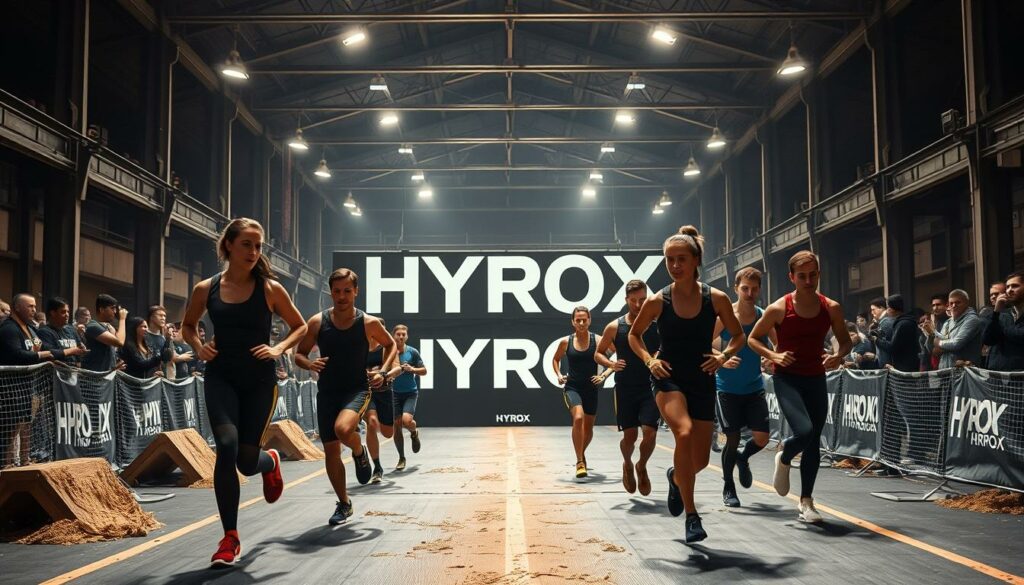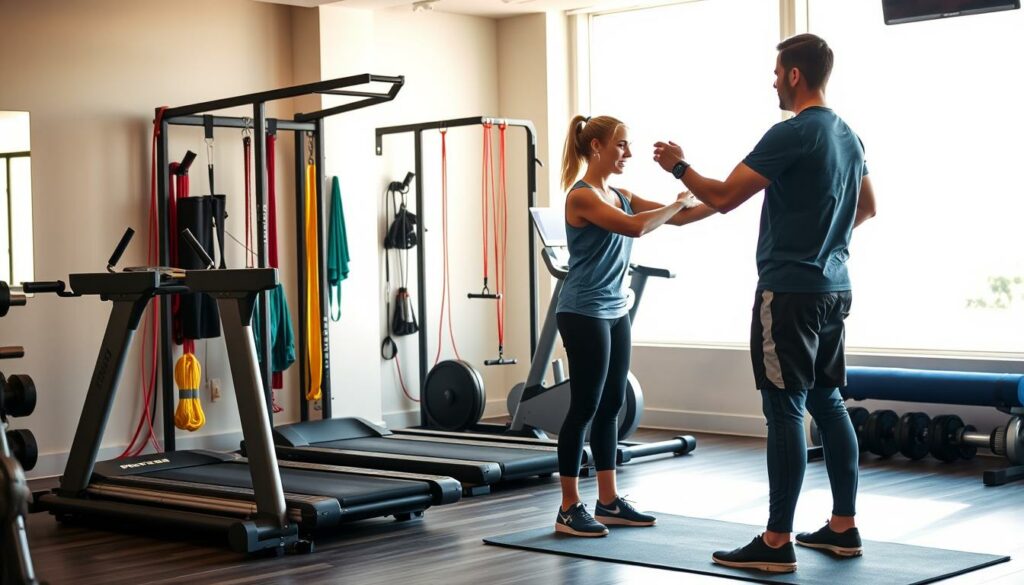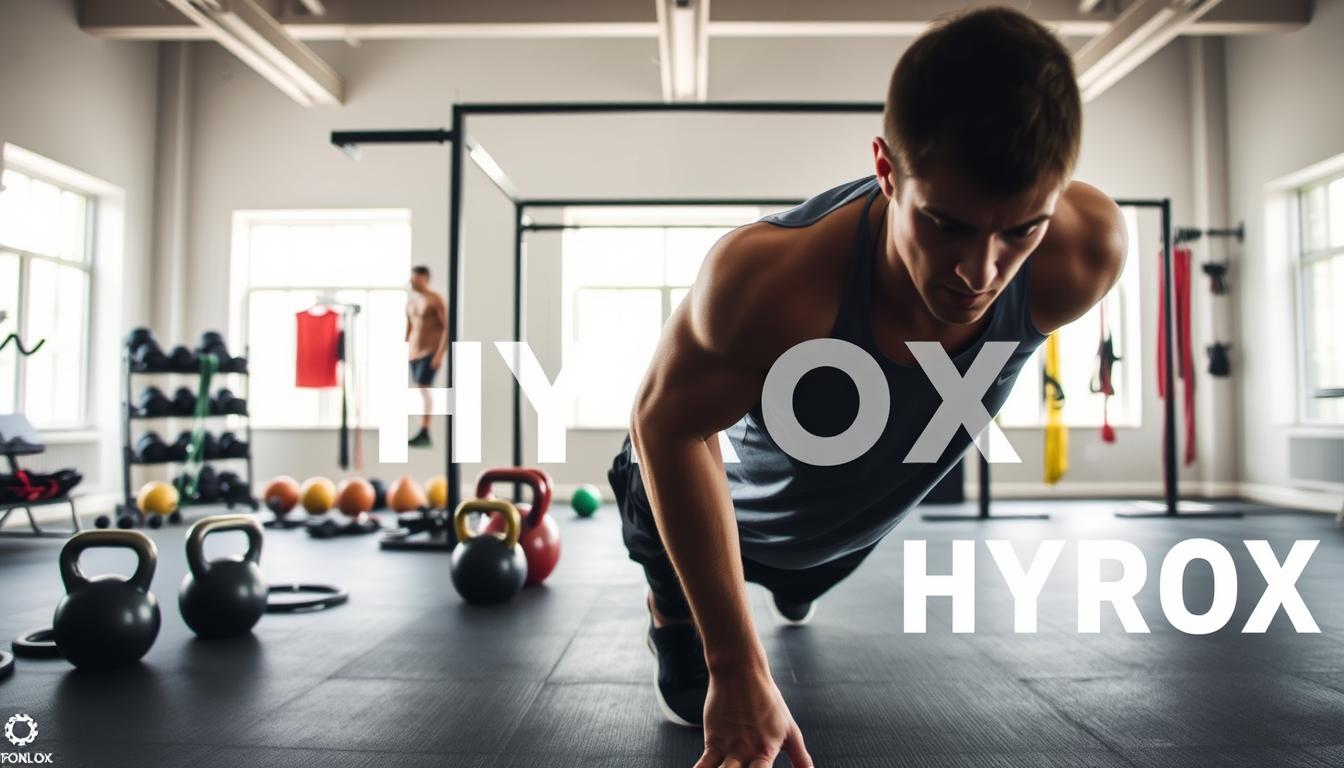Did you know HYROX has become super popular worldwide? It combines endurance, strength, and functional fitness. This shows we need a solid plan to face these challenges.
Getting ready for HYROX means having a good training plan. It’s not just about being in shape. It’s about being ready for HYROX’s special demands. Our guide will help you understand fitness challenges like HYROX and create a training plan for your fitness goals.
Key Takeaways
- Understand the format and demands of HYROX.
- Learn how to create a personalized training plan.
- Discover strategies to improve endurance and strength.
- Gain insights into achieving your fitness goals.
- Prepare yourself for the unique challenges of HYROX.
What is HYROX? Understanding the Fitness Race Format
HYROX is a mix of endurance training and functional fitness. It has become a big hit in the fitness world. This obstacle course racing format tests athletes’ overall fitness.

Understanding HYROX starts with its beginnings. It was created to be a full fitness test. It combines running with functional exercises, pushing athletes to their limits.
The Origin and Growth of HYROX
HYROX has quickly become popular all over the world. It attracts athletes from many fitness backgrounds. Its format is inclusive yet challenging, making it appealing to many.
Breaking Down the 8 Workout Stations
HYROX has 8 workout stations. These include Sled Push/Pull, Burpee Broad Jumps, and Wall Balls. There’s also Rowing, Ski Erg, Farmers Carry, Sandbag Lunges, and an 8km run.
Each station requires different skills and fitness levels. This makes HYROX a true test of overall fitness.
Physical Demands and Fitness Requirements
HYROX requires a lot of functional fitness, endurance training, and mental toughness. Athletes need to be well-rounded. They should have a strong base in running, strength, and agility.
Knowing these demands is key to preparing a good training plan.
Assessing Your Fitness Baseline for HYROX
Starting your HYROX journey means first knowing your fitness level. It’s key to create a fitness program that fits you perfectly.

Evaluating Your Current Endurance Level
First, check your endurance. This is about how long you can keep going during exercise. Try a simple test: see how long you can keep up a steady exercise pace, like running or cycling, at a moderate level.
Testing Your Functional Movement Capacity
Then, test how well you move. HYROX has exercises that need strength, flexibility, and coordination. See how well you do these and find areas to get better.
Setting Realistic Performance Goals
Now, set goals based on your fitness level. Think about your training time and HYROX’s challenges. Setting goals you can reach will keep you motivated and help you see your progress in your workout routines and fitness challenges.
Fitness experts say a good plan is vital to beat fitness challenges. So, your assessment is the base for a custom HYROX training plan.
Creating Your HYROX Training Plan
Making a personalized HYROX training plan is key to doing your best on race day. A good plan builds endurance, strength, and agility for the HYROX competition.
Periodization for Peak Performance
Periodization is a must in your HYROX plan. It breaks your training into phases for better performance. This way, you peak at the right time, ready for the competition.
Periodization has many benefits:
- It prevents injuries by slowly increasing intensity.
- It ensures you’re at your best for the competition.
- It keeps training interesting to avoid burnout.
Weekly Training Structure and Volume
A good weekly plan is essential for HYROX success. It should mix HIIT workouts, endurance, and strength. For example, spend 3 days on high-intensity, 2 on endurance, and 1 on strength.
Balancing Intensity and Recovery
It’s important to balance hard workouts with rest. Rest lets your body recover and adapt. Make sure to include rest days and active recovery like foam rolling and stretching.
Sample 12-Week Training Calendar
Here’s a 12-week HYROX plan example:
- Weeks 1-4: Start with basic endurance and strength.
- Weeks 5-8: Increase intensity and volume.
- Weeks 9-12: Focus on peak performance with HYROX simulation workouts.
Following a structured plan like this gets you ready for HYROX. Always listen to your body and adjust the plan to avoid injury and perform at your best on race day.
Running Training: Building the 8km Base
Running is key in HYROX, and a good training plan is vital. To build a strong base, mix different training methods into your fitness program.
Long slow distance runs are essential. They boost your heart health and stamina. Include one long run each week, slowly increasing the distance.
Long Slow Distance Runs
Long slow runs are vital for endurance. Run at a steady pace to save energy for other HYROX training. Start with 4km and aim for 6km or more as you get better.
Interval Training for Speed and Recovery
Interval training is also key. It mixes fast runs with rest. This boosts your speed and helps you recover.
Transitional Running Between Stations
In HYROX, running between stations is critical. Practice running at a steady pace to mimic event transitions.
Progressive Running Workouts
Keep improving with progressive running workouts. Increase the run’s intensity, distance, or frequency over time. Here’s a sample workout plan:
| Week | Distance | Intensity |
|---|---|---|
| 1-2 | 4km | Low |
| 3-4 | 5km | Moderate |
| 5-6 | 6km | High |
By using these methods, you’ll be ready for HYROX’s 8km run.
Mastering the Functional Workout Stations
To do well in HYROX, you need to get good at the functional workout stations. These stations test your fitness in many ways. They are a big part of the HYROX competition.
Sled Push/Pull Technique and Programming
Sled push and pull are key in HYROX training. To get better, keep your body stable and push with your legs. Add these to your HIIT workouts for 3-5 sets of 20-50 meters.
Burpee Broad Jumps and Wall Ball Efficiency
Burpees and wall balls need strength, power, and endurance. Practice burpees with the right form for quick movements and strong jumps. For wall balls, focus on throwing right and try different exercises like catch-and-throw and wall ball squats.
Rowing and Ski Erg Form and Pacing
Rowing and ski ergs boost your heart health and muscle strength. Keep your core strong and use your legs for the motion. Aim for a steady pace and quick recovery between efforts.
Farmers Carry and Sandbag Lunge Progression
Farmers carry and sandbag lunges test your strength, endurance, and coordination. Start with light weights and add more as you get stronger. Try different versions like uneven loads and obstacles to get ready for HYROX.
| Exercise | Technique Focus | Programming Recommendations |
|---|---|---|
| Sled Push/Pull | Strong, stable position; leg drive | 3-5 sets of 20-50 meters |
| Burpee Broad Jumps | Proper form; quick transitions; explosive jumping | 3-5 sets of 10-20 reps |
| Rowing/Ski Erg | Strong core; leg drive; consistent pace | 3-5 sets of 500-1000 meters |
| Farmers Carry/Sandbag Lunge | Proper form; gradual weight increase; uneven loading | 3-5 sets of 20-50 meters or 10-20 reps |
Essential Equipment for HYROX Training Plan
Having the right equipment is key for HYROX training. A good fitness program needs the right gear to prepare you for obstacle course racing.
First, decide between a commercial gym or a home gym. Commercial gyms offer many tools and expert advice. Home gyms are cheaper and more flexible.
Commercial Gym vs. Home Setup Options
Commercial gyms are great for those who like a structured place and lots of equipment. Home gyms are more affordable and can be customized to fit your needs. Think about your budget, space, and what you prefer.
Budget-Friendly Equipment Alternatives
You don’t have to spend a lot to start HYROX training. Options like resistance bands, jump ropes, and bodyweight exercises are cheaper. They can help you keep up a tough workout routine without spending too much.
Training-Specific Footwear and Apparel
Choosing the right shoes and clothes is important for HYROX training. Find shoes that work well for running and functional training. Clothes should be comfy, breathable, and right for obstacle course racing.
With the right equipment and gear, you’ll be ready to face HYROX challenges. This will help improve your performance.
Nutrition and Recovery for Optimal Performance
To conquer HYROX, it’s key to eat right and recover well. A balanced diet and good recovery can boost your HYROX performance and endurance.
Macronutrient Requirements for HYROX Athletes
HYROX athletes need a mix of carbs, proteins, and fats. Carbohydrates are the main energy source. Proteins help muscles recover and grow. Fats are important for hormones and energy.
Pre, During, and Post-Workout Nutrition
Nutrition is vital at different times. Pre-workout, eat complex carbs and proteins. During intense workouts, drink water and electrolyte drinks. Post-workout, focus on proteins for muscle repair.
Sleep, Active Recovery, and Mobility Work
Getting 7-9 hours of sleep is essential for recovery. Active recovery like light cardio and stretching can lessen soreness. Mobility work boosts flexibility and prevents injuries.
Sample Meal Plan for Training Days
| Meal | Food | Macronutrients |
|---|---|---|
| Breakfast | Oatmeal with banana and almond butter | 60g carbs, 20g protein, 15g fat |
| Lunch | Grilled chicken with quinoa and vegetables | 40g carbs, 50g protein, 10g fat |
| Pre-workout Snack | Apple with peanut butter | 30g carbs, 8g protein, 16g fat |
| Post-workout Shake | Whey protein with berries | 20g carbs, 30g protein, 0g fat |
| Dinner | Salmon with sweet potato and green beans | 60g carbs, 40g protein, 20g fat |
Progressive Workout Routines for HYROX Success
To conquer HYROX, you need a workout plan that gets better as you get fitter. A good fitness program builds endurance and strength. This is key for doing well in this tough fitness race.
Foundation Phase (Weeks 1-4)
The foundation phase is key for starting strong. In the first four weeks, aim for a regular workout routine. Include cardio, strength training, and functional movements.
Key workouts: Long slow distance runs, bodyweight strength training, and basic functional exercises like squats and lunges.
Building Phase (Weeks 5-8)
When you move to the building phase, your workouts get harder and longer. This phase pushes you with tougher exercises and more intense training.
- Interval training for running and other cardiovascular exercises
- Progressive overload in strength training
- Advanced functional movements like burpee broad jumps
Peak Performance Phase (Weeks 9-12)
In the peak performance phase, focus on getting ready for HYROX. Do specific workouts that match the race stations. Also, taper your training to be at your best on race day.
Workout Examples for Each Phase
Here are some workout examples for each phase:
| Phase | Workout Example | Description |
|---|---|---|
| Foundation | 30-minute steady-state run | Builds cardiovascular endurance |
| Building | Interval training: 4x800m at high intensity | Improves running speed and endurance |
| Peak Performance | HYROX simulation workout: 8km run + functional stations | Simulates the HYROX race experience |
By sticking to this structured workout plan, you’ll be ready for HYROX. You’ll reach your performance goals.
Race Day Strategy and Execution
To conquer HYROX, you need a solid race day plan. This includes tapering, pacing, and mental prep. A good plan helps you tackle obstacle course racing and reach your fitness goals.
Pre-Race Tapering Protocol
Tapering is key before the race. It means cutting back on intense workouts to recover and be ready for the big day. Most tapers last 7-10 days, with a slow drop in workout intensity.
Station-by-Station Pacing Strategy
Knowing the HYROX course layout is essential. Break the 8km run and 8 workout stations into smaller parts. This helps you manage your energy better. Practice pacing to build up your endurance for the challenges.
Mental Preparation and Visualization
Mental strength is as important as physical training. Visualize your race, overcoming obstacles and staying focused. Positive affirmations and breathing exercises can help with race day jitters.
Common Race Day Mistakes to Avoid
Watch out for common mistakes like starting too fast or ignoring nutrition. Also, make sure you know the course well. Stay adaptable and adjust your plan if needed.
| Strategy Component | Description | Benefits |
|---|---|---|
| Pre-Race Tapering | Reduce training intensity 7-10 days before the race | Allows for recovery and peak performance |
| Station-by-Station Pacing | Break down the course into manageable segments | Conserves energy and enhances endurance |
| Mental Preparation | Use visualization and positive self-talk | Boosts confidence and mental toughness |
Conclusion: Your Journey to HYROX Excellence
Starting your HYROX journey means having a solid training plan. This plan is key to beating the fitness challenges ahead. By following the advice in this article, you’re on the right track to reaching your fitness goals.
Success in HYROX isn’t just about physical training. It’s also about mental toughness and planning. Keep a balance between hard training and rest. And don’t be afraid to ask for help when you need it. With hard work and determination, you’ll conquer the HYROX course and reach your goals.
Your journey to HYROX success begins today. Stay dedicated to your training. Soon, you’ll be crossing that finish line, achieving your fitness dreams.


